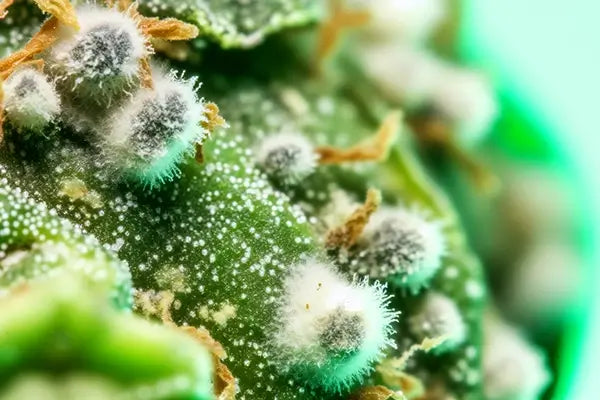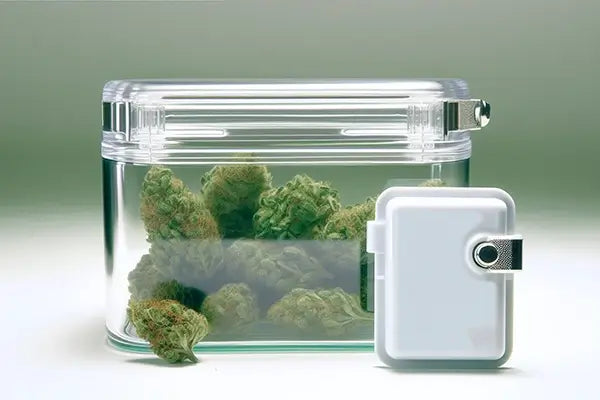Does Weed Expire? Understanding Cannabis Shelf Life & Potency
Apr 29, 2024
Wondering if your nugs are going to expire? The short answer is, cannabis doesn’t ‘expire’ in the traditional sense, but its quality can deteriorate over time due to factors like temperature, light, and moisture. Without proper storage, loss of potency and safety concerns like mold become real issues. In this article, we’ll explore how to recognize the signs of cannabis degradation to answer does weed expire, understand its shelf life, and learn how to store it correctly to maintain its benefits.
Key Takeaways
- Weed doesn’t ‘expire’ in the traditional sense, but improper storage can lead to decreased potency, taste, and safety concerns, such as mold, over time.
- The ideal storage for maintaining cannabis quality includes using airtight, UV-proof containers in a cool, dark place with humidity control to prevent degradation.
- Different cannabis products vary in shelf life and should ideally be consumed within a year; edibles with perishable ingredients have a much shorter life span, while some concentrates can last longer if stored correctly.
The Reality of Weed Expiration

Does weed ever truly expire? Not really. Unlike food that can spoil, weed doesn’t ‘expire’ in the traditional sense. However, it can reach a point where it is considered expired, with diminished therapeutic benefits. Factors such as:
- high temperatures
- moisture
- light
- time
can all cause the potency, flavor, and potential health benefits of cannabis to degrade over time.
Under ideal storage conditions, cannabis can maintain its quality for 6 months to a year before significant potency loss occurs. Keeping your weed ideally moist is crucial to preserving its therapeutic cannabinoids and ensuring it doesn’t lose its peak freshness.
Can Weed Become Unsafe?
As we mentioned, weed doesn’t ‘expire’ traditionally. But what happens when it’s stored improperly or for too long? Mold can grow on cannabis, making the product unsafe to consume by causing health issues such as lung infections and acting as a carrier for bacteria.
Moldy weed often has a musty smell, resembling hay, and can appear as white powdery or fuzzy spots, which are clear indications that the weed is no longer safe for consumption. While old weed itself isn’t necessarily dangerous, the potential for mold growth due to improper storage increases health risks over time. Consuming old cannabis with diminished potency might not harm you, but it could result in unpleasant effects like headaches, vomiting, and diarrhea.
How Potency Declines Over Time
Right after cannabis is harvested, THC, the psychoactive compound in weed, begins to degrade naturally. This degradation process transforms THC into CBN, a compound with distinct relaxing properties, resulting in a reduction in psychoactive effects.
Four environmental factors: temperature, humidity, air, and light, particularly UV rays, can accelerate the degradation of THC to CBN.
After one year, if stored properly, THC loses approximately 16% of its potency, and the loss continues with roughly 26% gone after two years. This illustrates how potency declines over time and the importance of proper storage to maintain the effects of your weed.
Identifying Expired Cannabis

Now that we’ve covered how weed can ‘expire,’ let’s move on to identifying expired cannabis. Changes in the aroma, texture, and particularly a harsher taste of cannabis can indicate it has passed its peak freshness, or in other words, the weed expire.
Cannabis that has degraded beyond its optimal state may exhibit the following signs:
- Loss of characteristic smell or a different aroma
- Changes in texture, such as dry and brittle or spongy feel
- Mold growth, which appears as funky smells and scuzzy formations
- General change in appearance
These indicators suggest that the cannabis has lost its potency and may not provide the desired effects.
Unpleasant Odors: Beyond the Skunk
When you open a container of fresh cannabis, you should be greeted with a pleasant aroma. This indicates that the fresh weed is still good. However, if that familiar, pleasant aroma starts to fade or change, it may suggest that your weed fresh is past its prime.
An unfamiliar odor, especially one resembling rotten eggs, is a strong sign that your cannabis may have expired. Harsh or altered smells can also be signs of cannabis that has been sitting too long and may no longer be fresh. So, make sure to give your weed a good sniff before you light up!
Visual Cues: Spotting Mold and Discoloration
Cannabis, often referred to as weed, is prone to mold, and two common types of weed mold are Powdery Mildew and Botrytis Blight (Grey Mold), both identifiable by a white powdery or fuzzy appearance. Powdery mildew presents as white, powdery or fuzzy spots on the plant, which can be mistaken for kief but appears more like sawdust upon close examination.
On the other hand, Grey mold, or botrytis, typically appears during late flowering or drying and is characterized by:
- a pale-grey, dry, cotton-like softness inside the bud
- mold can create cobweb-like structures around the buds that resemble spider mite damage
- mold can lead to discoloration in the plant material
Being aware of these visual cues can help you avoid consuming moldy cannabis.
Texture Changes: From Sticky to Brittle
The texture of your cannabis is another important indicator of its freshness. Fresh cannabis should have a crisp snapping sound when pulled apart, but if your cannabis exhibits a fragile or crumbling texture, it suggests that the product may be old and past its expiration date.
Sponginess or a crumbly texture when handling the cannabis flower can also indicate the product’s degradation and serve as a warning that it might no longer be suitable for consumption. So remember, when it comes to cannabis, texture matters!
Best Practices for Storing Cannabis

Proper storage is key to maintaining the quality and longevity of your cannabis. Glass and ceramic containers with airtight lids are superior storage options for cannabis, as they protect the weed from air and light, two factors that can degrade its quality. UV-proof glass containers offer additional protection against light exposure, crucial for preserving cannabis quality.
A cool and dark place, such as a cupboard or closet, helps to maintain a consistent temperature and protect your cannabis from light. Maintaining a temperature under 70 degrees Fahrenheit is vital to prevent the drying out of cannabinoids and terpenes. Humidity packs, like Boveda, can help maintain the ideal humidity level in your container, preserving terpenes and preventing overdrying.
Choosing the Right Container
Choosing the right container is crucial for proper weed storage, as it helps maintain the freshness and potency of your weed. An airtight container prevents air from making your weed stale and shields it from humidity, light, and temperature changes.
Glass containers, specifically mason jars, are favored for their ability to prevent air exchange and protect precious trichomes without imparting any flavors that could alter the weed’s quality. For added convenience, containers like the Medtainer even come with built-in grinders and offer waterproof and smell-proof features.
The Role of Humidity and Temperature
Humidity and temperature play a significant role in cannabis storage. Maintaining the proper humidity level between 55% and 65% is essential to preserve the color, aroma, and flavor profile of cannabis while preventing mold growth and over-drying. Too much moisture can also negatively impact the quality of the stored cannabis.
Exposure to high temperatures or significant temperature fluctuations can degrade cannabis by accelerating the degradation of terpenes and cannabinoids, reducing its potency. Humidity packs, such as Boveda, can be used to maintain optimum humidity levels for extended periods. For optimal preservation of cannabis, the temperature should ideally not exceed 70 degrees Fahrenheit.
Protecting Against Light and Air Exposure
Light and air exposure can degrade your cannabis, so it’s important to take steps to protect it. Light exposure degrades THC, and the smell of terpenes in weed can begin to fade in one to two weeks if not stored correctly.
Airtight containers, such as the Cannascape Container and Staze Jars, along with UV-proof glass and tinted jars, are critical for limiting light and air exposure to preserve cannabis quality. High-tech containers with humidity sensors and precise airflow control can extend the shelf life of cannabis beyond traditional storage methods.
Minimizing the oxygen in tightly packed airtight containers is crucial to maintaining the quality and humidity of the stored cannabis product.
Shelf Life of Various Cannabis Products

Cannabis comes in a variety of forms, each with a different shelf life dependent on storage conditions and product type. Cannabis, when stored properly, generally has a shelf life ranging from six months to a year with minimal degradation in quality. Medical marijuana can last from six months to over a year depending on storage conditions.
When stored correctly, cannabis-infused cosmetics and topicals can maintain their quality for up to two years. It is important to follow the recommended storage guidelines to ensure their longevity. CBD tinctures have a prolonged shelf life, with high-proof alcohol-infused tinctures remaining fresh for up to 10 years and oil-based tinctures for 2 years, assuming correct storage.
Other cannabis products like vape pens generally have a shelf life of 6 to 12 months; however, they can last around two to three years without significant potency loss. Different cannabis products require varying storage conditions to stay fresh and retain potency over time.
Flower Power: Keeping Your Bud Fresh
The shelf life of cannabis flower, also known as marijuana flower, is a crucial factor to consider. Cannabis flower can retain its quality for about a year with proper storage, while well-cured flower stored in optimal conditions can last up to 18 months.
The best method to preserve the freshness of your bud is by using an airtight container like a mason jar and storing it in a cool, dry place away from direct sunlight. But for the best flavor and effects, cannabis flower should be consumed within six months.
Concentrates and Their Longevity
Concentrates, like hash and wax, have a longer shelf life than many other cannabis products. Rick Simpson Oil, a type of cannabis concentrate, can remain potent for up to 10 years when stored properly. Other cannabis concentrates can last up to two years, with the potency starting to decline after twelve to eighteen months under proper storage conditions.
To maintain their potency over time, concentrates should be stored in a cool, dry place with minimal exposure to sunlight. Glass containers are ideal for storing concentrates to maintain quality over time.
Edibles, Tinctures, and Topicals
Edibles, tinctures, and topicals each have their own shelf life. Edibles that include perishable ingredients, such as eggs and milk found in cannabis-infused brownies and cakes, have a considerably shorter shelf life, typically around two to three days. THC gummies and candies, which lack perishable ingredients, can retain their quality for a period ranging from six months to a year.
To keep edibles fresh, follow these storage tips:
- Store them in their original packaging
- Keep them away from open air and direct light
- Store them in a cool environment
- Consider freezing edibles like gummies or baked goods to extend their shelf life.
THC tinctures have an indefinite shelf life when properly stored, with well-made, undisturbed tinctures lasting for years without significant degradation.
When to Consume Cannabis for Optimal Experience
For the best experience, cannabis should ideally be consumed within three to six months from the date of purchase. After opening the flower, marijuana retains its potency for about eight weeks but will begin to degrade sooner without proper storage.
As THC degrades into CBN over time, old weed may lose the expected psychoactive effects, which can diminish the overall user experience. So, to get the most out of your cannabis, timing is key!
Understanding the 'Use By' Date
The ‘use by’ date on cannabis products serves as an indication of when they are expected to begin losing their optimum quality, specifically in terms of aroma and potency. After the ‘use by’ date, cannabis can begin to degrade, resulting in a diminished sensory experience and a reduction in the intended psychoactive or medicinal effects due to loss of potency.
The ‘use by’ date for cannabis is not primarily about safety, as cannabis does not become unsafe right after this date; however, the quality, taste, and efficacy may deteriorate. So, it’s important to keep an eye on that date!
How Long Does Weed Last Before Losing Its Charm?
Ground cannabis should be used within 30 days to retain as many terpenes as possible. To ensure the highest quality of taste and potency, fresh cannabis flower is best used within six months, which can be found at your local dispensary.
The optimal period to consume cannabis for maximum effects is within six months to one year of purchase, as THC may degrade afterward, diminishing the intended experience. After six to twelve months, cannabis flowers might start to lose their characteristic flavor, aroma, and potency.
So, don’t let your weed lose its charm by storing it properly and consuming it within the right time frame!
Can Freezing Extend Cannabis Shelf Life?
Freezing cannabis immediately after harvesting can help preserve its freshness, flavor, and aroma, as well as reduce the degradation of THC. The best method to freeze cannabis is by using glass jars or vacuum-sealed containers, ensuring a consistent temperature to maintain trichome integrity.
While freezing can extend shelf life, it is not recommended for long-term storage due to risks such as trichome damage, condensation leading to mold, and a potential decrease in potency.
To defrost frozen cannabis, follow these steps:
- Leave it in a dark, room temperature location.
- Avoid disturbing the container to prevent trichome loss.
- Avoid rushing the process, as it can lead to mold.
Summary
To wrap up, while cannabis doesn’t ‘expire’ traditionally, its quality and potency can degrade over time due to factors like light, air, temperature, and humidity. Proper storage can significantly extend the shelf life of cannabis, ensuring that you get the most out of your product. Remember, the key is to store your cannabis in a cool, dark place, in an airtight container, and to consume it within the optimal time frame for the best experience. So, keep your weed fresh and enjoy it to the fullest!
Frequently Asked Questions
Does weed expire after 3 years?
Cannabis can lose potency and quality over time, with a significant decrease after three years, where it can lose approximately 34% of its THC content. It's best to consume it sooner rather than later to experience its full effects.
What does bad weed look like?
Bad weed can look overly pale or too dark, indicating improper cultivation, curing, or drying practices. Look for natural frosted trichomes on cannabis flowers.
Can a joint go bad?
Yes, a joint can go bad if it's exposed to excess heat and oxygen over time, leading to stale weed with a degraded taste and a less effective high. But, it's still considered safe to smoke.
What is the best way to store cannabis?
The best way to store cannabis is in airtight glass or ceramic containers, with humidity between 55% and 65%, and temperature below 70 degrees Fahrenheit. It's also crucial to protect it from light and air exposure.
Can freezing extend the shelf life of cannabis?
Freezing cannabis after harvesting can help preserve its freshness, flavor, and aroma, but it's not ideal for long-term storage due to potential risks like trichome damage, mold, and potency decrease.


